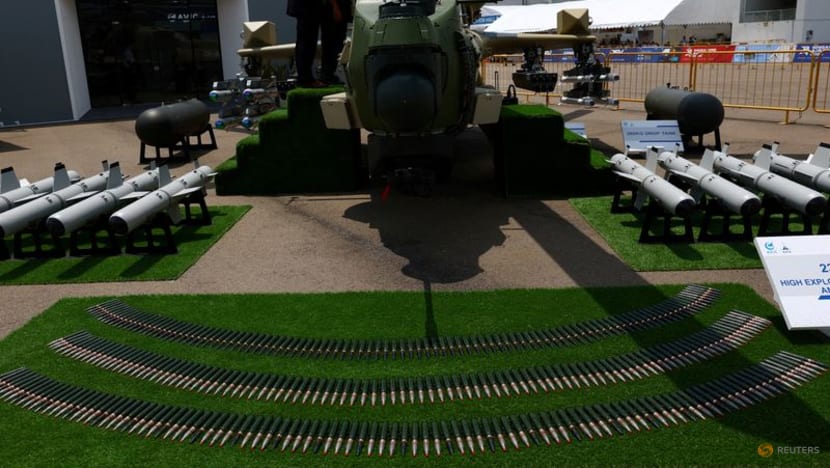Shifting geopolitical landscape changing the way defence deals are brokered between manufacturers, governments
The defence push is front and centre at the ongoing Singapore Airshow 2024, where industry players are participating in the trade show running from Tuesday (Feb 20) to Friday, before the public visiting days over the weekend.


This audio is generated by an AI tool.
SINGAPORE: Defence manufacturers have had to change the way they do business, in light of heightened geopolitical tensions around the world.
These include working more closely with governments when brokering deals, such as creating joint manufacturing capabilities in their countries to give them a stake in the process.
Countries are ramping up their defence capabilities to react effectively in urgent situations, from Japan boosting its defence budget to India committing part of its significant economic growth to defence.
The defence push is front and centre at the ongoing Singapore Airshow 2024, where industry players are participating in the trade show running from Tuesday (Feb 20) to Friday, before the public visiting days over the weekend.
GLOBAL THREAT ENVIRONMENT
Geopolitics is “in a very strange place” at the moment, Ms Natasha Pheiffer, BAE Systems’ regional managing director for Asia, told CNA’s Asia Now on Tuesday.
“With the current threat situation, all countries have to ensure that they boost their defences and security and that they therefore set up for any eventualities,” she said.
“The threat environment keeps changing and therefore military forces need to keep up with that, and companies like ourselves have to ensure that we keep up with the technologies.”
Mr Jeff Shockey, RTX’s senior vice president of global government relations, said his company’s mission is “kind of defending democracy around the world”.
“What you're seeing as a result of the war in Ukraine, everything that's going on in the Middle East and the potential build-up in the Taiwan Strait … countries are becoming more focused on what they need to do to defend themselves and be prepared if they need to go further than that,” he told CNA’s Asia First on Wednesday.
He said his firm is seeing global demand for its products in the United States and its allies around the world.
Ms Pheiffer said that one of BEA Systems’ aims is to “protect those who protect us”.
“So those war fighters on the frontline who are keeping the rest of us safe every night, we need to ensure that they go home safe to their families as well. And therefore, it's extremely important for us as a defence and security business, to ensure our technologies can do that,” she said.
RISING DEFENCE ORDERS
Despite the more tense geopolitical landscape, it has not necessarily become harder to seal defence deals, said Mr Shockey.
Potential clients are now additionally looking at how they can “co-develop, co-produce and co-sustain” the weapons production, so they can build up their own defence and security ecosystems as well, which is something RTX takes into consideration when making deals.
“We have to be more creative and understand the needs of our customers,” he said.
Mr Shockey cited the example of a large deal announced in January this year to supply countries in the North Atlantic Treaty Organization with GEM-T missiles, or the Patriot Guidance Enhanced Missile.
According to the company’s website, the GEM-T missile helps to counter tactical ballistic missiles, cruise missiles or enemy aircraft.
“We are going to do co-production in Germany with German industry to meet their demand, but also build up their internal capacity. So it's deals like that where you're seeing more creativity,” said Mr Shockey.
This comes at a time when the order books of the world's biggest defence contractors are reaching record highs.
Ms Pheiffer noted that BEA Systems operates across the land, air, sea and cyber spaces, making it unique and adding to its competitive advantage, as not many companies have such diversification.
“In some areas, obviously maritime is a lot more important because of what's happening in the environments around those countries, and in other land borders our land equipment and artillery equipment is a lot more favourable,” she explained.
While the firm’s research and design and manufacturing capabilities are mostly in the US and Britain, it has a presence in places like Australia and Europe as well, said Ms Pheiffer.
BAE systems is also involved in the production of Australia’s first nuclear submarines, to be delivered under the 2021 AUKUS partnership aimed at countering China's naval dominance in the Indo-Pacific.
The firm also has “a fair amount of equipment in Taiwan” and is working very closely with the Taiwanese to become “self-sufficient”, according to Ms Pheiffer.
“Another area for us which is extremely important as a company, is partnering with local companies across the region where we operate, and therefore Taiwan is one of those examples,” she said.
Mr William Blair, Lockheed Martin’s regional executive and vice president for Asia and India, said that India’s significant economic growth has also translated into its national defence spending.
He said that the firm has been in India for some five decades now, and has been a part of the evolution of the country’s aerospace and defence ecosystem.
“It's really driven by their requirements (and) their budget and I think what's impressive is they are translating that to real capability,” he told CNA’s Asia First on Thursday.
“India has both a policy and a budget (and) now, I think a sense of urgency to advance infrastructure, but also to advance their defence and security posture.”
FUTURE CHALLENGES
Mr Shockey said that one big challenge is meeting the demand for its products. His firm currently has a US$78 billion backlog in defence orders globally, and it is key to meet the needs of clients “who rely on us for part of their security portfolio”, he said.
“We have the same backlog type on the commercial side. Overall between defence and commercial, it's almost a US$200 billion backlog,” he said, adding that it shows that customers like the products.
Defence developers also have to understand and incorporate emerging technologies.
Mr Shockey said that RTX has a technology roadmap, focusing on 13 specific types of technology, including artificial intelligence (AI), and has invested some US$7 billion in research and development.
“Years ago when we developed some of our really powerful radars, we invested in, again, technology. We're constantly updating our roadmap and making sure we're placing the right bets and using the right resources,” he said.
Moving forward, one key area the firm will address is in drone defence, said Mr Shockey.
For Lockheed Martin, the digitalisation of defence systems is a critical part of the 21st century and a key part of its operational platforms, said Mr Blair.
The firm aims to address not just current cyber threats, but also anticipate future threats across all domains, including land, sea, air and space, he added.
“We have to, and we do, build in those cybersecurity solutions to have the resiliency needed as the threat evolves,” he said.














